Platform
Solutions
Industries
Compare
Resources
Posted by on March 25, 2025 — Updated on September 5, 2025
To open a Pilates studio, choose your studio model, create a detailed business plan, find a location and purchase Pilates equipment, get certified and build your class schedule, then market your studio to attract and retain clients. Learn how to start a Pilates studio and why Exercise.com is the best Pilates studio software for managing members, billing, and scheduling.
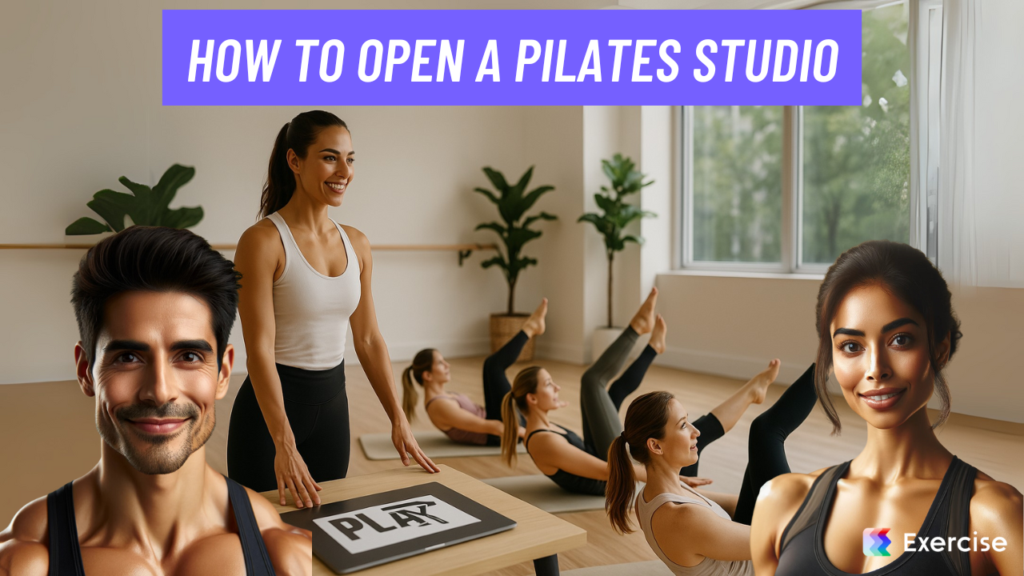
Opening a Pilates studio can be a fulfilling and profitable venture for certified instructors and wellness entrepreneurs alike. Whether you’re considering how to open a reformer Pilates studio, start a hot Pilates studio, or join a Pilates franchise like Club Pilates or Rise Pilates, having a clear Pilates business plan is essential. This guide walks you through each step of how to open a Pilates studio and build a successful, sustainable business. See why new Pilates studio owners choose Exercise.com when launching—manage clients, classes, billing, and marketing in one place.
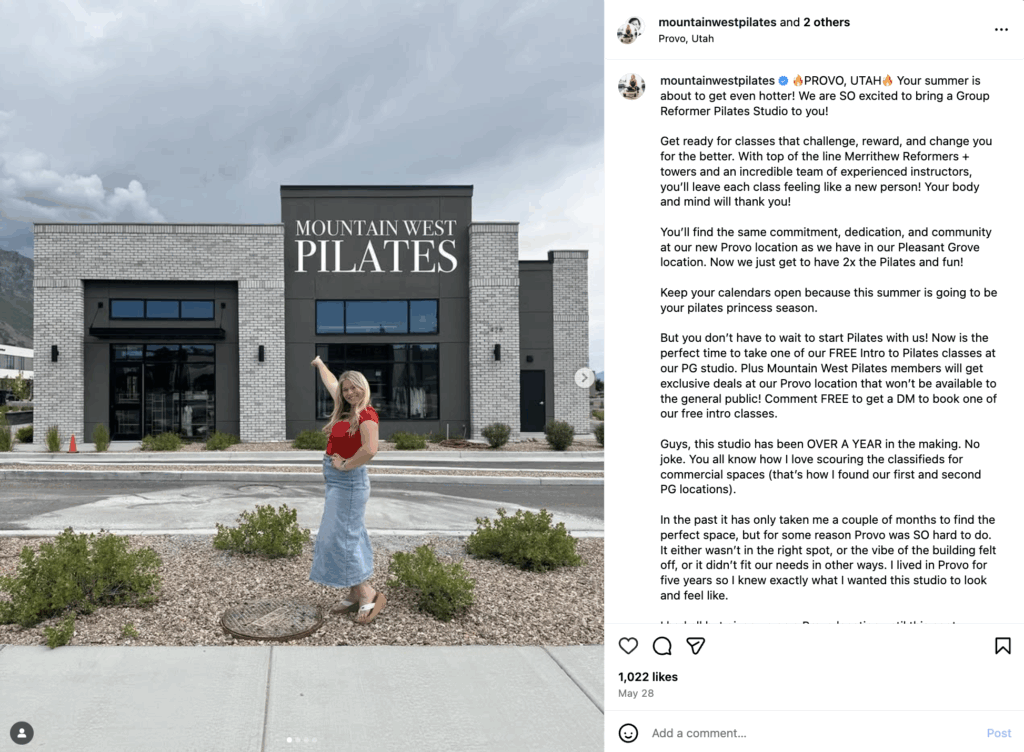
Opening a Pilates studio can be one of the most rewarding moves in the fitness industry, but it comes with unique challenges—from high Pilates studio startup costs to navigating whether to pursue a Pilates franchise opportunity or build your own brand. Owners often ask questions like “how much does it cost to open a Pilates studio?” or “is owning a Pilates studio profitable?” The reality is that profitability depends not just on real estate and equipment but on your ability to manage memberships, automate billing, deliver programming, and track retention.
That’s where Exercise.com comes in. As the best Pilates studio software, it helps you streamline everything from scheduling reformer classes to billing clients automatically, providing you with a unified dashboard for every KPI that matters.
| Step | Key Actions | How Exercise.com Helps |
|---|---|---|
| Step 1 – Create a Pilates Studio Business Plan | Outline your business model, pricing, services, and target market. | Offers business tracking, financial reporting, and CRM tools. |
| Step 2 – Choose Your Studio Type and Services | Decide between reformer Pilates, mat classes, hot Pilates, or hybrid models. | Supports multiple service offerings, class scheduling, and online delivery. |
| Step 3 – Secure a Location and Design Your Studio | Select a space, purchase Pilates equipment, and create a welcoming design. | Manage facility usage, class schedules, and instructor assignments. |
| Step 4 – Get Certified and Hire Qualified Instructors | Complete a Pilates certification and hire trained staff. | Store and manage instructor credentials and class planning. |
| Step 5 – Market and Grow Your Pilates Studio | Build a strong brand, attract clients, and retain members. | Automates marketing, online waivers, and lead generation. |
Figuring out how to open a Pilates studio—or even how much it costs to open a Pilates studio—can feel daunting, especially when you’re juggling equipment costs, certification requirements, scheduling logistics, and trying to create a profitable business model. From choosing between a boutique setup or reformer Pilates franchise to drafting a Pilates studio business plan, finding the right Pilates studio design ideas, and coming up with strong Pilates studio names, every detail matters.
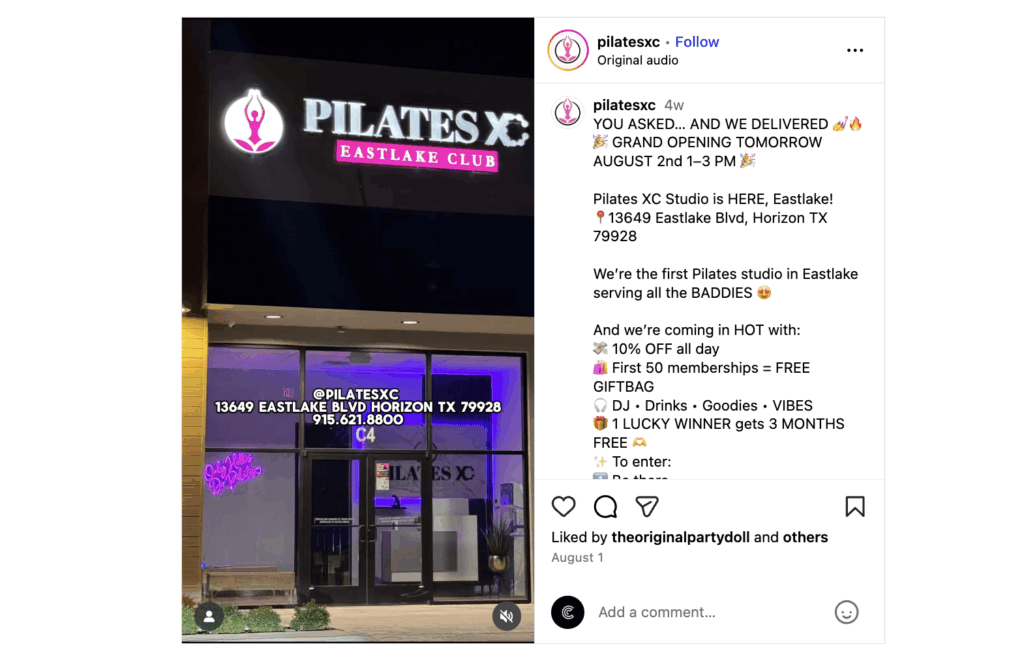
Many aspiring owners also struggle to understand the real Pilates studio profit margin and how to scale beyond just themselves. Exercise.com solves these challenges by helping you streamline operations from day one—manage class bookings, track revenue, deliver programs, and grow your brand with a custom branded Pilates app—so you can focus on movement, not management.
If you’re wondering how to open a Pilates studio, then you’ll need a solid Pilates studio business plan, certified instructors, quality Pilates equipment, and the best Pilates studio software management systems in place. Whether you’re launching a boutique Pilates reformer space, joining a Pilates franchise like Club Pilates, or creating your own brand from scratch, it all starts with a clear strategy. Download free fitness templates including a Pilates studio business plan template, fitness class waiver forms, pricing models, and more to streamline the setup process.
So if you’re researching how much it costs to open a Pilates studio or how to open a reformer Pilates studio, know that startup costs can vary depending on your location, equipment, and whether you’re opening at home or investing in a franchise like Rise Pilates or Club Pilates. Pilates reformer machines, space design, instructor certifications, and business insurance all factor into the equation. Whether you’re opening a Pilates studio in the UK, India, or the U.S., Exercise.com helps you run your entire business in one place. From class scheduling and payments to client tracking and liability waivers, you’ll have the tools to launch and grow your Pilates studio with confidence. Get a demo now.
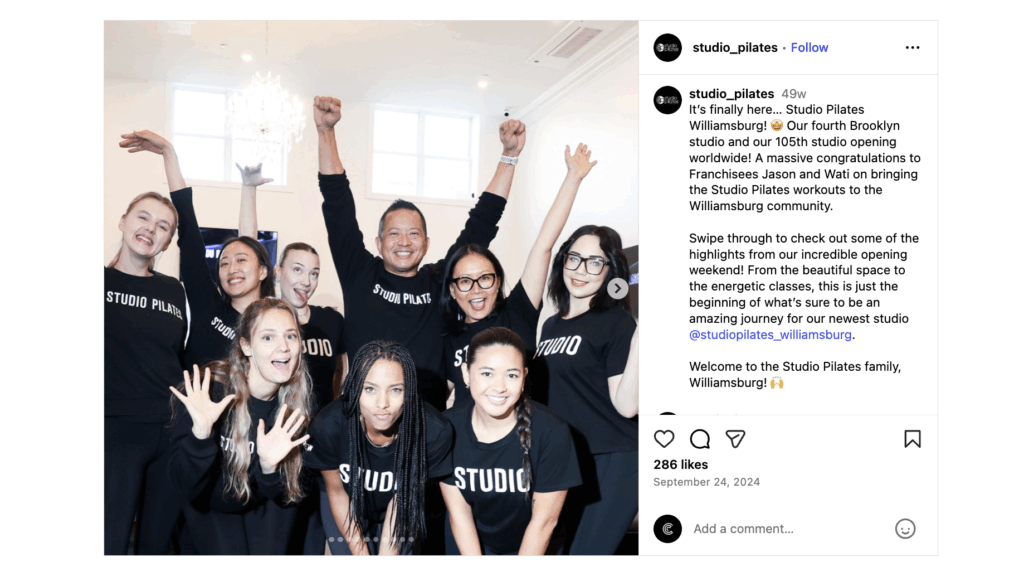
Whether you’re starting a Pilates class, opening a hot Pilates studio, or managing a full Pilates reformer facility, Exercise.com supports you every step of the way. See why the many fitness business owners who have learned how to open a gym or learned how to open a yoga studio or even learned how to make a Pilates app, have all trusted Exercise.com to run their fitness business with the best software for fitness businesses. From Pilates studio design ideas and branding tools to client engagement and business automation, we help you build a profitable Pilates business. See why Exercise.com is the best Pilates studio software around. Get a demo now.


Start by developing a detailed Pilates studio business plan or downloading a Pilates studio business plan PDF or template to work from. Your plan should include:
Whether you’re starting a boutique studio or exploring a Pilates studio franchise, this step is critical. Consider scalability, local competition, and potential Pilates business milestones.
Exercise.com supports your studio’s business operations with class management, financial reporting, and CRM tools all in one platform.
Read More:
Decide on the type of studio you want to open:
If you’re wondering how to start a Pilates class or expand into multiple formats, make sure your space and schedule accommodate varied offerings.
With Exercise.com, you can manage both in-person and virtual Pilates classes, sell packages, track attendance, and automate client communication.
Read More: Gym Business Models
Finding and setting up the right space is essential. If you’re asking how much does it cost to open a Pilates studio, expect a wide range based on size, location, and services.
Explore Pilates studio design ideas for creating a clean, peaceful, and functional space. If you’re starting with less capital, consider opening a Pilates studio at home or renting shared studio space.
Exercise.com provides scheduling and facility management tools to help you maximize space usage and bookings.
Read More:
If you’re launching solo or plan to teach, you’ll need to complete a Pilates instructor course or certification. Top programs include:
Pilates teacher training advice: Look for programs that are PMA-approved and offer reformer, mat, and specialty training.
If hiring a team, make sure you vet certifications and experience. Create a compensation plan and align staff with your brand culture.
With Exercise.com, you can manage instructor schedules, store credentials, and organize class rotations across your studio.
Once your studio is ready, it’s time to launch and grow your brand. Strategies include:
If you’re concerned about competition, franchising, or sustainability, research Pilates studio going out of business trends and learn from others’ challenges. A strong brand and customer experience can increase longevity.
Exercise.com helps automate your marketing, manage your online booking system, send email campaigns, and even collect online waivers through a digital online Pilates waiver template.
Read More: Gym Marketing Ideas
Most Pilates studio owners struggle with fragmented tools—one platform for billing, another for scheduling, another for progress tracking, and no single source of truth. That’s where Exercise.com stands apart.
With Exercise.com, you get:
This unified platform eliminates the inefficiencies that come from trying to connect 5+ different tools. It’s ideal for Pilates franchises, independent studio owners, or anyone exploring how to grow a Pilates studio.
The cost to open a Pilates studio varies significantly based on location, facility size, and whether you pursue a franchise Pilates studio or independent concept. Costs typically include:
| Expense Category | Average Cost (US) | Notes |
|---|---|---|
| Leasehold Improvements | $30,000 – $150,000 | Flooring, mirrors, lighting, HVAC |
| Pilates Reformers & Equipment | $25,000 – $100,000 | Commercial-grade reformers, towers, chairs |
| Licensing & Permits | $2,000 – $10,000 | Depends on city/state |
| Marketing Launch Budget | $5,000 – $25,000 | Grand opening, local ads, digital marketing |
| Staffing (Trainers/Admin) | $5,000 – $40,000 monthly | Salaries and payroll taxes |
| Studio Management Software | $200 – $1,000 monthly | Centralized software vs. multiple tools |
Rather than piecing together booking apps, CRM systems, and billing tools, Exercise.com provides a single platform that reduces operating expenses and ensures your Pilates business model is scalable from day one.
Franchising can be a lower-risk path since brand, systems, and marketing are already established. But costs vary dramatically:
| Franchise Brand | Initial Franchise Fee | Estimated Total Startup Cost | Ongoing Royalties |
|---|---|---|---|
| Club Pilates | $60,000 | $220,000 – $310,000 | 7% of gross sales |
| Studio Pilates | $50,000 | $200,000 – $280,000 | 6% of gross sales |
| KX Pilates | $40,000 | $180,000 – $250,000 | 6% of gross sales |
| Strong Pilates | $50,000 | $200,000 – $300,000 | 6% of gross sales |
| Independent Studio | N/A | $80,000 – $150,000 | N/A |
Franchise owners still need to track Pilates franchise profit margins carefully. With Exercise.com, you gain franchise-wide reporting dashboards, allowing multi-location operators to compare Pilates studio revenue across all sites in real time.
Global entrepreneurs often ask: “What is the cost to open a Pilates studio startup cost in India versus the US or UK?” Here’s a breakdown:
| Country | Average Startup Cost | Key Cost Drivers |
|---|---|---|
| United States | $100,000 – $300,000 | Commercial reformers, real estate, payroll |
| United Kingdom | £75,000 – £200,000 | Smaller studios, but high city rents |
| Australia | AUD $120,000 – $250,000 | Strong franchise presence, equipment import fees |
| India | ₹30 – 60 lakh | Lower real estate but import equipment costs |
| Canada | CAD $100,000 – $220,000 | Facility retrofits and staff wages |
No matter the market, the best Pilates studio management software is essential for scaling profitably. Exercise.com supports international payment gateways, local tax compliance, and multi-currency billing, ensuring global Pilates operators can grow without tech headaches.
Many entrepreneurs ask, “is a Pilates studio profitable?” or “how much do Pilates studio owners make?” On average, Pilates studio profit margins range from 10–25% depending on class capacity, pricing strategy, and retention. A strong Pilates studio business model leverages:
Exercise.com gives owners the ability to sell both in-person and online Pilates programs through custom-branded apps, opening new revenue streams beyond studio walls.
One of the most common questions is are Pilates studios profitable or how much do Pilates studios make. On average, Pilates studio profit margins range from 15%–30%, with many boutique operators reporting Pilates studio revenue of $250,000+ annually once membership stabilizes. Owners often ask how much does a Pilates studio owner make—and while it depends on expenses, successful owners can earn $75,000–$150,000+ annually.
Pain point: margins shrink quickly without effective retention. Exercise.com fixes this with CRM automations, client engagement tools, and branded apps for Pilates studios that keep members booked and accountable.
Choosing between owning a Pilates studio outright or investing in a Pilates franchise depends on your goals.
For some, exploring how to start a fitness business or even hybrid concepts like how to start an online fitness business offers better ROI.
Owners often ask:
The answer lies in offering a boutique Pilates experience online and in-person. With Exercise.com, you can expand beyond in-studio reformer classes by selling digital memberships, challenges, and online courses through a branded Pilates app. This creates additional revenue streams that offset Pilates studio startup costs. See how to make a Pilates app for more.
Whether you’re weighing the Club Pilates franchise cost, building a boutique studio from scratch, or comparing Pilates studio startup costs UK vs US, success comes down to planning, execution, and having the right systems. The ICP pain point is clear: too many owners overspend on equipment but overlook management. With Exercise.com, you get the best Pilates studio software—an all-in-one platform for scheduling, billing, marketing, and member retention. Stop piecing together multiple apps. Build a Pilates business that’s profitable, scalable, and future-ready with Exercise.com.
A frequent pain point is “how to grow a Pilates studio”. Many owners overspend on ads without tracking ROI. Exercise.com provides built-in marketing automation tools, so you can:
Read More: Gym Marketing Ideas
Whether you’re considering a Pilates franchise for sale, evaluating Club Pilates franchise cost, or building your own brand from scratch, the key to profitability lies in strong management. Exercise.com is the best Pilates studio software because it provides:
For more, see Pilates Studio Insurance, How to Make a Pilates App, and Fitness Niche Ideas.
Learning how to open a Pilates studio—whether it’s a hot Pilates space, a reformer-based studio, or a multi-service wellness brand—requires strategic planning, community-building, and efficient operations. If you’re considering how long it takes or how hard is it to open a Pilates studio, know that with the right systems in place, your business can thrive.
Book a demo with Exercise.com today to see how our all-in-one fitness business software can help you launch, manage, and grow your Pilates studio successfully.
Opening a Pilates studio can be a fulfilling and profitable endeavor—especially with the rising demand for reformer Pilates, hot Pilates, and group fitness experiences. Whether you’re exploring how to open a Pilates studio from scratch or researching Pilates studio franchise options like Club Pilates, this guide breaks down the essentials.
Use the table below to assess your path to owning a successful Pilates business—and learn how Exercise.com can power your growth every step of the way.
| Factor | Details |
|---|---|
| Startup Costs | $30,000–$200,000+ depending on location, reformer type, and franchise or independent |
| Studio Type | Reformer Pilates, Mat Pilates, Hot Pilates, or Hybrid Group Fitness + Pilates |
| Space Requirements | 500–1,500 sq ft for boutique studios; up to 3,000 sq ft for multi-reformer spaces |
| Essential Equipment | Reformers, Cadillacs, Wunda Chairs, mats, props, mirrors, and sound system |
| Staffing Needs | Certified Pilates instructors (PME, BASI, Balanced Body), studio manager, receptionist |
| Profit Potential | Profit margins often 20–40% depending on pricing, retention, and utilization |
| Licensing & Certifications | Pilates certification (e.g., Balanced Body, BASI) and local fitness business licensing |
| Business Model Options | Independent, franchise (e.g., Club Pilates, Rise Pilates), mobile, or home-based studio |
| Marketing Strategy | Leverage local SEO, referral programs, intro offers, and social media |
| How Exercise.com Helps | Manage class booking, instructor schedules, waiver forms, memberships, and payments |
From managing reformer scheduling to tracking client packages and instructor commissions, Exercise.com is the best platform for Pilates professionals. Whether you’re starting a hot Pilates class from home or launching a Pilates studio franchise, our custom software helps streamline operations and boost revenue.
Ready to open a Pilates studio the right way? Book a demo with Exercise.com and see why top studios choose our platform.
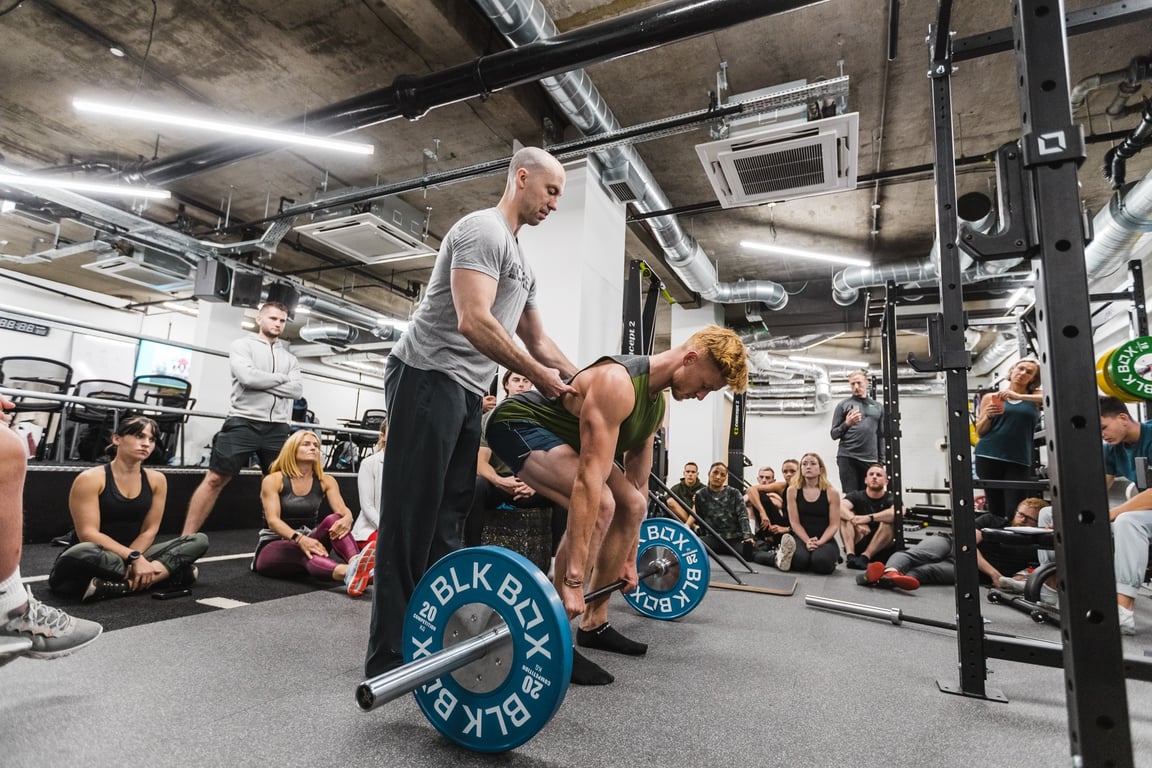

Opening a Pilates studio can be a rewarding business venture for fitness professionals passionate about helping clients improve their strength, flexibility, and overall wellness. Whether you’re considering how to open a Pilates studio from scratch, exploring Pilates studio franchise opportunities, or planning a home-based studio, this comprehensive guide will walk you through the essential steps, costs, and considerations.
The Pilates industry continues to grow as more people recognize the benefits of this controlled exercise method focused on core strength, proper alignment, and mind-body connection. With proper planning and execution, a Pilates studio can become a profitable business that makes a positive impact on your community’s health.
Before diving into the specifics of how to open a Pilates studio, consider which business model best fits your goals, experience, and resources.
| Business Model | Initial Investment | Pros | Cons | Best For |
|---|---|---|---|---|
| Independent Studio | $50,000-$150,000+ | Complete control; brand ownership; flexibility | Higher risk; no established systems; full responsibility | Experienced instructors with business acumen |
| Franchise (Club Pilates, etc.) | $175,000-$500,000+ | Established brand; proven systems; support network | High franchise fees; less flexibility; ongoing royalties | First-time business owners; less industry experience |
| Home-Based Studio | $15,000-$50,000 | Low overhead; flexible schedule; tax benefits | Limited capacity; professional image challenges; zoning issues | Instructors testing concept; part-time business |
| Reformer-Focused Studio | $75,000-$200,000+ | Premium service offering; higher per-session rates | Higher equipment costs; additional space needs; specialized instruction | Studios in affluent areas; specialized trainers |
| Mat-Based Studio | $25,000-$75,000 | Lower startup costs; simpler operations; flexibility | Lower per-session rates; more competition | New instructors; limited startup capital |
| Hybrid Model (Mat + Reformer) | $60,000-$175,000+ | Service variety; multiple price points; cross-selling | Complex scheduling; varied instructor requirements | Growing studios; diversified client base |
Reformer Pilates studios focus on machine-based training and typically:
Hot Pilates combines Pilates principles with a heated environment and requires:
Starting a reformer-focused studio requires:
Whether you’re opening a reformer Pilates franchise, starting from scratch, or buying an existing studio, your studio management system is one of your most important investments.
The best Pilates studio software should include:
Exercise.com checks every box—and then some. You can manage your entire studio, including front-desk operations, instructor schedules, member communications, digital programs, and financial reports—all from one login.
One of the most common questions is “how much does it cost to open a Pilates studio?” While costs vary significantly based on location, size, and business model, here’s a comprehensive breakdown:
| Expense Category | Independent Studio | Franchise | Home-Based Studio | Notes |
|---|---|---|---|---|
| Real Estate/Rent | $2,000-$8,000/month + deposit | $3,000-$10,000/month + deposit | $0-$500/month | Location significantly impacts cost; typically requires first/last month + security deposit |
| Renovation/Build-out | $10,000-$75,000+ | $75,000-$150,000+ (per franchise specs) | $1,000-$15,000 | Flooring, mirrors, sound treatment, reception area, bathrooms, etc. |
| Equipment (Reformers) | $25,000-$100,000+ | $50,000-$150,000+ (package deals) | $5,000-$25,000 | $5,000-$10,000 per commercial reformer; 5-15 reformers is typical |
| Additional Equipment | $5,000-$25,000 | $10,000-$40,000 | $1,000-$10,000 | Towers, chairs, barrels, mats, props, etc. |
| Technology/Software | $2,000-$7,000 setup; $200-$500/month | $5,000-$15,000 setup; $300-$800/month | $1,000-$3,000 setup; $100-$300/month | Booking system, payment processing, computers, music, etc. |
| Permits/Licenses | $500-$5,000 | $500-$5,000 | $200-$2,000 | Business license, certificate of occupancy, health permits, etc. |
| Insurance | $1,500-$5,000/year | $2,000-$7,000/year | $800-$2,500/year | Liability, property, workers comp, etc. |
| Marketing/Branding | $5,000-$20,000 initial | $10,000-$30,000 initial (some provided) | $1,000-$5,000 initial | Website, signage, grand opening, promotional materials, etc. |
| Franchise Fee | N/A | $40,000-$60,000 | N/A | One-time payment to franchisor |
| Legal/Professional Fees | $2,000-$7,000 | $3,000-$10,000 | $500-$3,000 | Business formation, contracts, accounting setup, etc. |
| Initial Staffing | $5,000-$15,000 | $7,000-$20,000 | $0-$5,000 | Hiring, training, initial payroll until revenue stabilizes |
| Working Capital | $20,000-$50,000 | $30,000-$80,000 | $5,000-$15,000 | 3-6 months of operating expenses to cover until profitable |
| TOTAL RANGE | $75,000-$300,000+ | $200,000-$500,000+ | $15,000-$75,000 | Significant variation based on size, location, and concept |
The cost to open a Pilates studio varies significantly by location:
For a basic independent studio in a moderate-cost area, expect a minimum investment of $75,000-$100,000. More comprehensive studios in premium locations can easily require $200,000-$300,000+.
As a franchise, Club Pilates requires a total investment of approximately $200,000-$500,000, including:
A home-based Pilates studio typically requires $15,000-$50,000, including:
Quality equipment is central to a successful Pilates studio. Here’s what you’ll need:
| Equipment Type | Cost Range | Quantity Needed | Lifespan | Considerations |
|---|---|---|---|---|
| Reformers | $3,500-$10,000 each | 4-15+ | 7-10 years | Core equipment; commercial grade essential; space-consuming |
| Towers/Cadillacs | $4,000-$8,000 each | 1-4 | 10+ years | Versatile; space-consuming; premium offering |
| Pilates Chairs | $1,500-$3,000 each | 2-6 | 10+ years | Space-efficient; good for circuit training |
| Barrels (Spine Corrector) | $500-$1,500 each | 2-6 | 10+ years | Complement to reformers; specialized exercises |
| Mats | $50-$200 each | 10-20 | 2-5 years | Essential for mat classes; affordable entry point |
| Small Props | $1,000-$5,000 total | Various | 1-5 years | Balls, bands, rings, weights, etc. |
| Specialized Equipment | $3,000-$10,000 total | Various | 5-10 years | Jumpboards, specialty accessories, etc. |
Popular commercial-grade reformer brands include:
| Area | Square Footage | Purpose | Design Considerations |
|---|---|---|---|
| Reformer Area | 50-80 sq ft per reformer | Primary workout space | 4-6 ft between reformers; mirror placement |
| Mat Class Area | 25-40 sq ft per student | Floor-based classes | Clean lines of sight; comfortable flooring |
| Reception | 100-300 sq ft | Client check-in; retail | Professional appearance; functional flow |
| Changing Rooms | 100-300 sq ft total | Client privacy | Secure storage; cleanliness; accessibility |
| Storage | 50-200 sq ft | Props; cleaning supplies | Organization systems; accessibility |
| Instructor Area | 50-150 sq ft | Staff breaks; preparation | Privacy; functional workspace |
| Bathrooms | 50-200 sq ft | Client comfort | Cleanliness; accessibility; professional appearance |
When setting up a reformer-focused studio:
Creating the right atmosphere enhances client experience and retention:
| Requirement | Approximate Cost | Timeline | Notes |
|---|---|---|---|
| Business Entity Formation | $100-$800 | 1-4 weeks | LLC recommended for liability protection |
| Business License | $50-$500 | 1-4 weeks | Required at local level |
| Employer Identification Number (EIN) | $0 | 1-2 days | Required for taxes and hiring |
| Certificate of Occupancy | $100-$1,000 | 2-8 weeks | Required for commercial space |
| Zoning Verification | $0-$500 | 1-4 weeks | Ensure location permits fitness business |
| Health Department Permits | $0-$500 | 2-8 weeks | May be required in some locations |
| Music Licensing | $300-$800/year | 1-2 weeks | Required for playing music (ASCAP/BMI) |
| Signage Permits | $50-$500 | 2-8 weeks | Often required for exterior signage |
Essential insurance coverage includes:
All studios should implement liability waivers. Essential elements include:
Note: Have your waiver reviewed by an attorney familiar with fitness businesses in your jurisdiction. Digital waiver systems integrated with booking software are highly recommended.
| Certification | Cost | Duration | Recognition | Focus |
|---|---|---|---|---|
| Balanced Body | $1,800-$4,500+ | 6-12+ months | High | Comprehensive; adaptable |
| STOTT Pilates | $2,000-$5,000+ | 6-12+ months | Very High | Precise; contemporary approach |
| Classical Pilates (Various) | $3,000-$7,000+ | 12-24+ months | Very High | Traditional; authentic methods |
| Peak Pilates | $1,500-$4,000+ | 6-12+ months | High | Classical foundation; modern application |
| Polestar Pilates | $4,000-$8,000+ | 12-18+ months | High | Rehabilitation focus; medical integration |
| Club Pilates Teacher Training | $2,000-$4,000 | 6-8+ months | Medium-High | Franchisee-focused; standardized |
| PMA Certification | $450 exam fee + prerequisites | Exam only | Very High | Industry standard credential |
| Comprehensive Programs | $5,000-$15,000+ | 12-24+ months | Very High | Full apparatus; advanced skills |
| Mat-Only Certifications | $400-$1,500 | 1-3+ months | Medium | Limited scope; entry-level |
When pursuing Pilates certification:
| Position | Compensation Range | When to Hire | Key Responsibilities |
|---|---|---|---|
| Lead Instructor(s) | $35-$75/hour or $45K-$80K+ salary | Immediately | Primary instruction; program development; staff mentoring |
| Additional Instructors | $25-$60/hour | As schedule demands | Class instruction; client retention; studio maintenance |
| Studio Manager | $40K-$70K+ annually | With 8+ classes/day | Operations; scheduling; client relations; staff coordination |
| Front Desk/Reception | $15-$25/hour | With 5+ classes/day | Check-in; retail sales; answering inquiries; light cleaning |
| Cleaning Staff | $15-$25/hour | With own facility | Maintaining cleanliness; equipment sanitation; supplies |
Consider these compensation structures:
Choosing the right name is crucial for branding. Consider these approaches:
| Marketing Channel | Cost Range | Effectiveness | Best Practices |
|---|---|---|---|
| Website/SEO | $1,500-$7,000 setup; $200-$1,000/month maintenance | High | Mobile-responsive; online booking; client testimonials |
| Social Media | $0-$2,000/month | Medium-High | Before/after content; technique videos; community building |
| Email Marketing | $30-$300/month | High | New client nurturing; member communications; promotions |
| Local Partnerships | $0-$1,000/month | Medium-High | Wellness practitioners; complementary businesses; corporate partners |
| Introductory Offers | Cost of service discount | Very High | First class free/discounted; intro packages; friend referrals |
| Client Referral Program | $25-$100 per referral | Very High | Reward both referrer and new client; systematize asking |
| Community Events | $200-$2,000 per event | Medium | Demonstrations; health fairs; charity events |
| Google Business/Local SEO | $0-$500/month | High | Comprehensive profile; regular updates; review solicitation |
| Paid Digital Advertising | $500-$3,000/month | Medium-High | Targeted local ads; remarketing; clear offers |
Running effective classes is crucial for retention:
When launching new classes:
A comprehensive business plan should include:
Pilates studios can be profitable, but success depends on multiple factors:
Owner compensation varies widely based on business model, location, and involvement:
Note: These figures represent owner compensation after expenses but before taxes. Many owners also teach classes, adding additional income.
Typical profit margins by business model:
| Business Model | Typical Profit Margin | Revenue Drivers | Cost Considerations |
|---|---|---|---|
| Mat-Based Studios | 20-35% | Volume; lower price point | Lower equipment costs; higher instructor ratio needed |
| Reformer Studios | 25-40% | Premium pricing; equipment advantage | High equipment costs; lower instructor:client ratio |
| Hybrid Studios | 20-35% | Service diversity; multiple price points | Operational complexity; space efficiency challenges |
| Franchise Studios | 15-30% | Brand recognition; proven systems | Franchise fees; royalties; standardized pricing |
| Boutique Concept | 25-45% | Premium pricing; specialized expertise | Higher marketing costs; premium location expenses |
Track progress through these key milestones:
Early Stage (0-12 months)
Growth Stage (1-3 years)
Maturity Stage (3+ years)
Understanding common failure points helps avoid them:
| Franchise | Initial Investment | Franchise Fee | Royalty Fee | Training/Support | Number of Locations |
|---|---|---|---|---|---|
| Club Pilates | $200,000-$500,000 | $49,500 | 7% | Comprehensive; 200+ hours | 700+ |
| Stretch Lab + Pilates | $175,000-$425,000 | $40,000 | 7% | Moderate; franchise-focused | 100+ |
| BODYBAR Pilates | $175,000-$400,000 | $42,500 | 6% | Comprehensive; owner+staff | 50+ |
| Pilates ProWorks | $250,000-$550,000 | $45,000 | 6% | Moderate; equipment-focused | 25+ |
| Core Pilates | $150,000-$300,000 | $35,000 | 6% | Moderate; regional support | 15+ |
| Rise Pilates | $200,000-$450,000 | $40,000 | 6.5% | Comprehensive; marketing support | 20+ |
When evaluating reformer Pilates franchises, consider:
As the largest Pilates franchise, Club Pilates offers:
Converting part of your home into a Pilates studio presents unique considerations:
Offering Pilates in corporate settings presents a unique business opportunity:
Digital and hybrid offerings expand reach and revenue potential:
Once your studio reaches profitability, consider these growth strategies:
Building a sustainable Pilates business requires:
Even in the early stages, consider your long-term exit options:
Finding and keeping quality instructors is a persistent challenge:
Building and maintaining a strong client base requires:
Common financial pitfalls and solutions:
Effective technology infrastructure streamlines operations:
| Software Type | Popular Options | Monthly Cost | Key Features to Prioritize |
|---|---|---|---|
| Class Management | Exercise.com, MINDBODY, Vagaro, ZenPlanner | $125-$300+ | Client booking; instructor scheduling; automated reminders |
| Payment Processing | Exercise.com, Square, Stripe, PayPal | 2.5-3.5% + $0.25-0.30/transaction | Integration with booking; recurring payment capabilities; secure processing |
| Client Communication | Exercise.com, Mailchimp, Constant Contact, Emma | $30-$200 | Segmentation; automation; template designs; analytics |
| Accounting | Exercise.com, QuickBooks, Xero, Wave | $15-$80 | Payroll integration; expense tracking; tax preparation; financial reporting |
| Marketing Automation | Exercise.com, HubSpot, ActiveCampaign, Klaviyo | $50-$300 | Lead nurturing; client journey mapping; behavioral triggers |
| Client Retention | Exercise.com, Perkville, FitnessBI, Spark Loyalty | $50-$200 | Rewards programs; usage tracking; retention risk alerts |
Beyond software, these operational systems ensure consistency and quality:
Ongoing education enhances business success:
For those developing instructors or seeking advanced education:
| Organization | Membership Cost | Benefits | Best For |
|---|---|---|---|
| Pilates Method Alliance (PMA) | $150-$225/year | Certification; continuing education; conferences; standards | All professionals |
| Local Pilates Collectives | $50-$200/year | Local networking; resource sharing; community events | Regional connection |
| Small Business Administration (SBA) | Free | Business guidance; loan programs; mentor connections | Business development |
| SCORE | Free | Mentorship; workshops; business templates | Startup guidance |
| Fitness Industry Association (FIA) | $250-$500/year | Industry data; advocacy; business resources | Multi-service studios |
Opening and operating a successful Pilates studio requires careful planning, quality execution, and ongoing adaptation. The most successful studios share these characteristics:
By addressing the elements outlined in this guide, you’ll be well-positioned to open and operate a Pilates studio that not only survives but thrives. The journey requires significant investment of time, resources, and passion—but the rewards of building a business that transforms clients’ lives through the power of Pilates can be extraordinary.
Remember that success rarely happens overnight. Most profitable studios take 1-2 years to reach stability, and 3-5 years to achieve their full potential. With persistence, continuous improvement, and focus on delivering exceptional client experiences, your Pilates studio can become both personally and financially rewarding.


The cost to open a Pilates studio typically ranges from $50,000 to $150,000, depending on factors like location, equipment (e.g., Reformers, Cadillacs, Wunda Chairs), lease terms, studio size, and staffing. A small boutique Pilates studio may start closer to the $50,000 mark, while a fully equipped studio with premium branding and facilities will lean toward the higher end. Startup capital is often used for renovations, licensing, marketing, and Pilates studio management software like Exercise.com, which helps streamline scheduling, billing, and client management from day one.
You don’t need a special license specifically to open a Pilates studio, but you do need standard business licenses, permits, and liability insurance required in your city or state. If you plan to hire instructors or teach yourself, it’s highly recommended that instructors are certified through a recognized program like STOTT, Balanced Body, or Polestar. Proper certifications enhance credibility and meet the expectations of today’s well-informed clients.
Owning a Pilates studio can be very profitable with the right business model, marketing strategy, and client retention systems in place. Profit margins can reach 20–30% once operating costs stabilize. Recurring memberships, high-ticket private sessions, small group classes, and retail sales can drive profitability. Many successful owners also use Exercise.com to increase efficiency, improve client engagement, and grow their business with built-in billing, class booking, and performance tracking tools.
A typical Pilates studio needs at least 800 to 1,200 square feet for group classes, with an additional 300–500 square feet for private training rooms or reception areas. The number of Reformers and other apparatus you plan to offer will determine the exact layout. Studios that also include retail or wellness services may require more space.
Pilates studio owners typically earn between $50,000 and $120,000 annually, depending on the studio’s size, location, clientele, and operating costs. Well-established studios in high-demand areas with a full client roster and diversified revenue streams can earn significantly more.
Pilates instructors typically earn $30 to $100 per class, depending on experience, certification, and whether they teach group or private sessions. Full-time instructors working at a premium studio or operating their own can make $50,000 to $80,000+ per year, especially if they teach private clients or specialty classes.
Expect $120,000–$250,000 depending on facility size and equipment brand. Leasing reformers can reduce Pilates studio setup cost initially, but long-term ownership often yields better Pilates studio profit margins.
Pilates studios often achieve higher average revenue per client because reformer classes are priced at a premium. With Exercise.com, you can maximize retention through automated reminders, loyalty programs, and hybrid memberships.
Studios can lease reformers, pursue Pilates startup funding, or use small business loans. Exercise.com helps make your Pilates studio business plan more attractive to lenders with detailed financial forecasting and reporting features.
Commercial-grade reformers not only improve class quality but also reduce replacement costs long term. Exercise.com complements equipment investments by ensuring every class, client, and payment is tracked in one platform, so you see ROI clearly.
Technically, you can teach Pilates without a certification in some locations, but it is strongly discouraged. Clients expect instructors to have formal training, and many insurance companies won’t cover unqualified instructors. Getting certified is a wise investment in your credibility, safety, and long-term success.
Yes, most Pilates instructors are paid per class or per session. Rates vary based on location and experience, typically ranging from $25–$100 per class. Instructors teaching private sessions usually earn more than those leading group classes.
Club Pilates is considered the most successful Pilates franchise, with over 800 locations worldwide. It offers an accessible franchise model, strong brand recognition, and comprehensive support for franchisees. Their business model focuses on small-group classes and consistent member engagement.
Pilates instructors make the most money in major metropolitan areas like New York, Los Angeles, San Francisco, and internationally in cities like London or Sydney. Teaching in luxury wellness clubs or owning your own studio can also significantly boost income.
To become a Pilates studio owner, you should first get certified as an instructor or hire qualified staff, then write a business plan covering your target market, location, equipment, staffing, and finances. Secure funding, lease a space, and invest in equipment. Using Exercise.com for Pilates studio management helps handle scheduling, memberships, and marketing as your business grows.
The minimum size for a functional Pilates studio is about 600 to 800 square feet, which can accommodate 3–5 Reformers and a small area for check-in or private training. For group Reformer classes, more space is recommended.
Yes, doing two Pilates classes a day is generally safe for healthy individuals and can help improve strength, flexibility, and endurance faster—especially when classes vary in intensity. However, it’s important to allow recovery time and adjust based on client fitness levels.
Yes, like most fitness businesses, Pilates studios require startup capital—typically between $50,000 and $150,000, covering equipment, leasehold improvements, marketing, and operations. Starting lean with mat-only classes or mobile services can reduce initial costs.
Owning a Pilates franchise like Club Pilates costs between $180,000 and $250,000, including franchise fees, build-out, equipment, and working capital. This price varies based on location, real estate, and staffing needs.
You’ll need around $50,000 to $150,000 to start a Pilates studio, depending on whether you’re offering mat-only or full Reformer classes, the cost of real estate, and your branding or marketing needs. A leaner mobile or home-based model can lower the cost.
Private Pilates sessions typically cost between $60 and $120 per hour, depending on the instructor’s experience, location, and whether equipment is used. Studios often offer package pricing for improved retention.
Opening a workout studio costs between $30,000 and $150,000, depending on size, equipment, staffing, and services offered. The cost will be higher for specialized training studios with premium equipment and tech integrations.
To become a Pilates studio owner, you’ll need to develop a solid business plan, secure funding, lease space, purchase equipment, hire staff or teach yourself (if certified), and set up studio operations. Investing in software like Exercise.com helps with scheduling, billing, and client management, ensuring your business runs smoothly.
Top Pilates franchises include Club Pilates, BODYBAR Pilates, Session Pilates, and STRONG Pilates. Each offers varying levels of support, branding, and investment. Choose one that aligns with your vision, budget, and preferred training style.
The best Pilates studio software is Exercise.com, offering all-in-one functionality for scheduling, billing, memberships, workout delivery, staff management, and performance tracking. Its customization options and ability to support hybrid in-person and online business models make it ideal for Pilates studio owners.
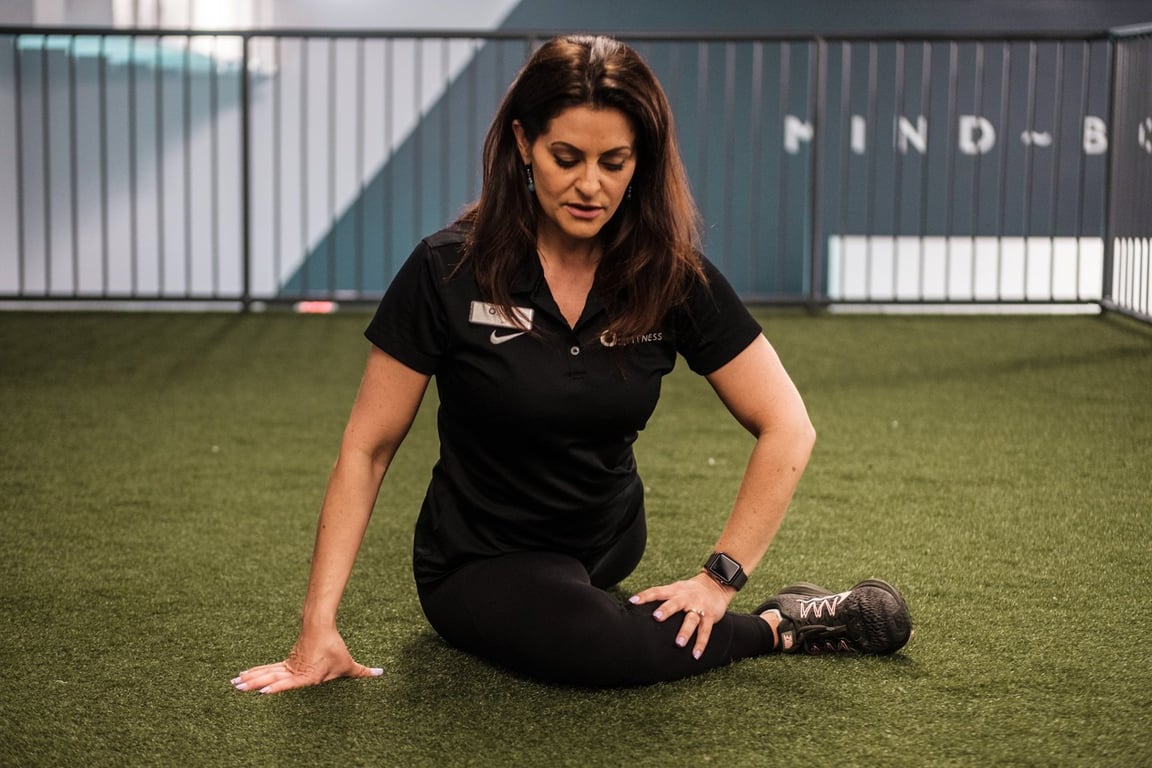

 Tyler Spraul
Tyler Spraul